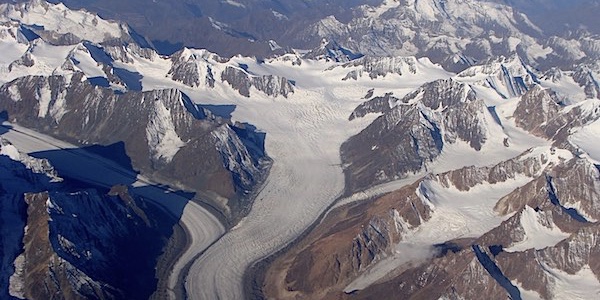LADAKH by BICYCLE – SHIMLA to LEH via SPITI
Bicycle Tour - 25 days/ 20 days bicycling
About LADAKH
Ladakh is a part of the Indian Himalayas, located between the Kunlun mountain range in the north and the main Himalayas to the south. As it is the only Indian region that lies north of the Great Himalayan Range, it is very different from the rest of the Indian Himalayas. In many ways it resembles Tibet. Although part of India now, and earlier of the princely state of Kashmir, Ladakh has been an independent kingdom for almost 900 years.
Ladakh is best known for its Buddhist (‘Tibetan’) culture and its starkly beautiful mountain scenery. It is inhabited by a mix of Indo-Aryan and Tibetan people. Especially the latter, with their colorful Buddhist culture, have given the region the nickname of ‘Little Tibet.’
As a result of its location, in the rain shadow of the Great Himalayan Range, the climate is extremely dry. And due to the high altitude – most valleys are situated at 3300m or higher – winters can be extremely cold. Summers, however, are generally pleasant if not warm and sunny.
Read more…Read less…
TREKKING PARADISE
Ladakh in the narrower sense is the Indus Valley with adjacent areas. It is bordered by two mountain ranges: in the northeast by the Ladakh Range, in the southwest by the Zanskar Range. The area around the capital Leh, and further upstream towards Tibet, is referred to as Upper Ladakh. Lower Ladakh is the area further downstream towards Kargil, where the Indus enters Pakistan.
The remoter areas of Zanskar, Nubra and Rupshu are now seen as regions of Ladakh. In the past, these areas were sometimes part of Ladakh, sometimes not. They can be visited from Leh by car, on foot (trekking) or by bicycle. Trekking or bicycling would be our advised means of transport. That is, if you are up to it. Because, while jeep trips in Ladakh are very rewarding indeed, trekking and bicycling will give you an even more in-depth experience of the land and the people, with the added bonus of a total renovation of body and soul.
Ladakh can be reached by air or overland. On this tour, you fly in and out. In case you have enough time available, we strongly recommend taking one of the overland routes, in which you travel by train and car to Ladakh through Srinagar in Kashmir, Manali or Shimla, the latter two both in the Himalayan state of Himachal Pradesh. These are among the greatest car journeys in the world.
Region
Ladakh
(India)
Best Time
July. - Sept.
No. Of Days
25 days,
20-day bicycle tour
Trip Character
Bicycle tour
Sleeping Altitude
3100 - 4645 m.
Trek Character
Homestays & guesthouses
Bicycle tour: level 3
Price
INR XXX/ $ XXX
ABOUT THIS TOUR
On this tour, you’ll explore the majestic mountains and remote idyllic villages of Ladakh by bicycle. Going at your own pace along millennia-old caravan trails and interacting with the utterly friendly and contented Ladakhi people, while staying at home-stays, you’ll see and experience so much more of this fairy-tale country than the jeep-sitters will.
Ladakh is situated on the Tibetan Plateau, and it’s high. The altitude will force you to go slower than you are used to back home, but that only adds to the experience. There is no hurry on this trip. Being on the trail, winding your way up to a high pass with majestic views and coming down again to be greeted by cheerful kids and waving prayer flags, that’s what it is all about. You’ll have your back-up car to make the ride easier or shorter if you want.
Depending on your time window, you may also be lucky enough to witness one of the spectacular, colourful and mystical Buddhist festivals, called tsechus, where monks dance in brilliant costumes wearing ancient masks of gods, demons and mythical animals. If the dates coincide, we’ll make sure that you are able to squeeze in a fantastic festival on this holiday as well.
YOUR custom-made TRIP
The tour described here, as well as the other ones on our website, are mainly meant as suggestions. We would be happy to offer you a travel proposal that fully meets your personal demands and expectations. That means that you choose where you want to go, what level of accommodation and type of transport you want and what activities you prefer.
Please let yourself be inspired by this and other trips on our website and then drop us a line (or call us) to explain your travel wishes. We will be happy to help you put together the perfect trip. You can reach us over e-mail, Messenger, Whatsapp or mobile phone.
EXTENSIONS & VARIATIONS
Apart from the tour as described here, you could consider the following add-ons and changes:
- Spend one or two more days at interesting places along the road, such as Sangla, Kalpa, Rarang, Nako, Tabo or Tsokar (near Debring). Basically, travel slower.
- Explore the Indus Indus Valley further north of Leh (visiting Lamayuru and Alchi, for instance or visit the beautiful Nubra Valley River from Leh.
- Consider a light or medium-level trek in the surroundings of Leh.
- Spend a day rafting on the Indus. There are different grades available, so there is the easy but fun to do level as well. Professional oarsmen will be with you in any case. You will be picked up from your hotel and dropped off there again at the end of the day, a picnic lunch is included.
On this trip, you will have your bicycles with you at all times, as well as a pick-up truck. This gives you ample opportunities to make small side trips from any of the places that you visit.
Route Map
ITINERARY
-
Day 1: Train Delhi - Chandigarh & car Chandigarh - Shimla
Your train for Chandigarh leaves at 7:20 and takes close to 4 houurs At Chandigarh RWS our driver will await you, and take you on a beautiful 1,5 hr drive up into the mountains to your destination of the day, Shimla. Altitude: 2200m. -
Day 2: In Shimla
A full day to recover from the journey, get used to the altitude and explore the pleasant hill station of Shimla. Altitude: 2200m. -
Day 3: Biking Shimla - Nawar (25 km, +740 m, –660 m; 2 - 3 h)
Your first day of cycling will be easy. You’ll set out on the old Hndustan-Tibet road and pedal about 25km, climbing and descending about 700m, to the small town of Nawar. Altitude 2200 → 2585 → 2275m. -
Day 4: Biking Nawar - Narkanda (35 km, +665 m, –589 m; 3 - 4 h)
A relaxing day in Leh, maybe buy some souvenirs and check out the museum and some garden restaurants in town. Altitude 3500m. -
Day 5: Biking Narkanda - Rampur (126 km, +844, –2573,2 h)
Today will be mostly descending as we go down to the Sutlej River valley. This holy river has its source near Mt. Kailash and Lake Mansarowar in Tibet. The road that runs along it provided one of the easiest ways to acces Tiibet from India in the old days. On the way you pass Sarahan, with its beautiful Bhima kali Temple. Overnight in Rampur. Altitude 2720 → 820 → 975m. -
Day 6: Biking Rampur - Wangtu (57 km, +2080 m, –1745 m; 3 - 4 h)
In the 18th century, Rampur was the capital of the small mountain state of Bushahr (or Bushair). A beautiful palace till remains. Today you follow the Sutlej further to the town of Wangtu. There will be considerably more climbing the the first days, as there are many instances where the road climbs out of the valley to overcome steep slopes and outcrops. Altitude 975 → 1760 → 1570m. -
Day 7: Biking Wangtu - Sangla (38 km, +1685 m, –585 m; 4 - 5 h)
After another 20km along the Sutlej, we veer off to the South and enter the lush green Sangla Valley, known for its apple orchards. Altitude 1570 → 2650m. -
Day 8: Biking Sangla - Chitkul - Sangla (57 km, +1465 m, –1465 m; 4 - 5 h)
Today you’ll explore the beautiful valley further to the east, following an ancient (and still operational) trading route to Tibet.You’re allowed to go as far as the picturesque village of Chitkul. Altitude 2650 → 3425 → 2650m. -
Day 9: Biking Sangla - Rarang (59 km, +1875 m, –1860 m; 4 - 5 h)
Today you’ll return to the Sutlej River and then continue your gradual climb in the direction of high Tibetan borderlands. All in all there is some serious limbing to be done before you reach the small town of Rarang, home to a Buddhist temple with an ancient library and pleasant but simple homestay. Altitude 2650 → 1800 → 2665m. -
Day 10: Biking Rarang - Poo (47 km, +1585 m, –1665 m; 5 h)
If not yesterday, then today you will definitely notice a gradual change in the landscape as it gets drier and more sparsely vegetated. Culturally, the many small temples along the road show a transition from a mix of Hinduism and Buddhism to a purely Buddhist environment. Poo even has a temple attributed to the famous Buddhist sage Rinchen Zangpo, who lived a thousand years ago. Altitude 2665 → 1760 → 2590m. -
Day 11: Biking Poo - Nako (39 km, +1945 m, –910 m; 5 h)
Today a sturdy climb awaits you again. After about 12 km you’ll reach the confluence of the Sutlej and the Spiti River. Here, the road turns north and starts following the Spiti River. This place is the closest point to the Tibetan border of this tour (about 6 km as the crow flies). Nako is beautiful ‘Tibetan’ village with mud-brick houses decorated with prayer flags. Altitude 2590 → 3620. -
Day 12: Biking Nako - Tabo (64 km, +1590 m, –1930 m; 4 - 5 h)
Yesterday and the days before you have actually been traversing the Himalayan Range, without climbing it, as the Sutlej and Spiti River have conveniently cut deep gorges through the mountains. You’re in the Trans-Himalaya now. Tabo is above all know for its very old Buddhist monastery, founded by Rinchen Zangpo. Altitude 3620 → 3280m. -
Day 13: Biking Tabo - Kaza (48 km, +955 m, –570 m; 3 - 4 h)
As you’ve doen a lot of climbing the last few days you might want to take break and enjoy the beautiful Spiti Valley. Or you press on to Kaza, Spiti’s capital which is about 50km further. Altitude 3280 → 3660m. -
Day 14: Biking Kaza - Kibbar - Kaza (40 km, +1165 m, –1165 m; 4 h)
Today you can explore the higher reaches of the Spiti Valley, such as Kibbar village, at almost 4200m, and Ky Monastery, set atop a large hill. Or you take a rest and explore the many little cafes and restaurants of Kaza. Altitude 3660 → 4125 → 3660m. -
Day 15: Biking Kaza - Losar (58 km, +1090 m, –685 m; 4 - 5 h)
Up we go again, as you make your two-day ascent to the Kunzum La (pass). Tonight’s halting play is the pleasant village of Losar. Altitude 3660 → 4060m. -
Day 16: Biking Losar - Gramphu (80 km, +1695 m, –2255 m; 6 h)
Looping back to the south you cross back over the Himalayan Range at the 4590m high Kunzum La pass, amply decorated with prayer flags. Great views of Himalayan Peaks and glaciers await you as you descend to Gramphu, where the Spiti road joins the Manali-Leh Highway. Altitude 4060 → 4545 → 3340m. -
Day 17: Biking Gramphu - Jispa (73 km, +1345 m, –1410 m; 5 - 6 h)
You’re in Lahaul now. These and the following days traffic will be considerably more than in the Spiti Valley. Today you’ll ride to Jispa, following the Chandra River to a above its confluence with the Baga River through a magnificent and again greener landscape. Altitude 3340 → 3275m. -
Day 18: Biking Jispa - Serchu (78 km, +2060 m, –962 m; 6 - 7 h)
Today is the day of all days. It is a 2000m climb to the Baralacha La, the main pass separating Lahaul/ Himachal Pradesh from Ladakh. The landscape is stark and forbidding. Once on the other side, it’s a leisurely 25 km downhill coasting to the tented camps of Serchu (often wrongly spelled as Sarchu). Altitude 3275 → 4895 → 4370m. -
Day 19: Biking Keylong Sarai/Serchu - Pang (84 km, +1633 m, –1476 m; 3 - 4 h)
You’re in Ladakh now. Trees are nowhere to be seen and the mountains are bare but colourful. Even though the Himalayan Range is behind you, two passes await you today, each of them higher then he Baralacha La, before you descend to the tented enclave of Pang. Altitude 4370 → 5070 → 5270 → 4520m. -
Day 20: Biking Pang - Debring (42 km, +344 m, –237 m; 3 - 4 h)
A relatively easy day for a change. After 40 minutes climbing to get out of the gorge of Pang you’ll find yourself on a vast level expanse called the More Plains which you'll follow till Debring, the highest nigh halt on this journey (4645m). Altitude 4520 → 4645m. -
Day 21: Biking Debring - Rumtse (55 km, +943 m, –1385 m; 5 h)
The last serious climb of this journey awaits you right after breakfast. On top of the Taglang la (5330m) you get fantastic views of this area called Rupshu, part of the West-Tibetan plateau called Changtang. Dropping down 1250 m, you reach the first Ladakhi settlement at Rumtse. Altitude 4645 → 5330 → 4185m. -
Day 22: Biking Rumtse - Leh (78 km, +715 m, –1410 m; 3 - 4 h)
Further descending through a colourful gorge with red sandstone your reach Karu on the Indus River. From here it’s another 35 km over a comfortable highway to Leh, the capital of Ladakh. Altitude 4185 → 3500m. -
Day 23 & 24: In Leh
Leh is a pleasant little city with many restaurants and shops, and opportunities for short walks. Highly recommended are excursions by taxi to some of the many nearby Buddhist monasteries. Altitude: 3600m. -
Day 25: Flight Leh - Delhi
Early morning you will be transferred to the airport. The flight to Delhi goes over the Himalayan Range, and is one of the most spectacular flights in Asia.
HIGHLIGHTS OF THIS TOUR
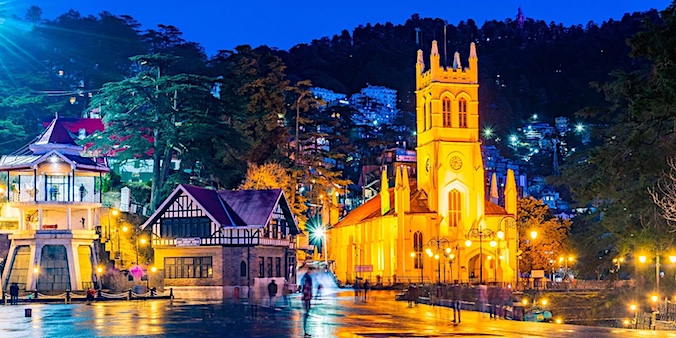
SHIMLA
SUTLEJ GORGE (KINNAUR)
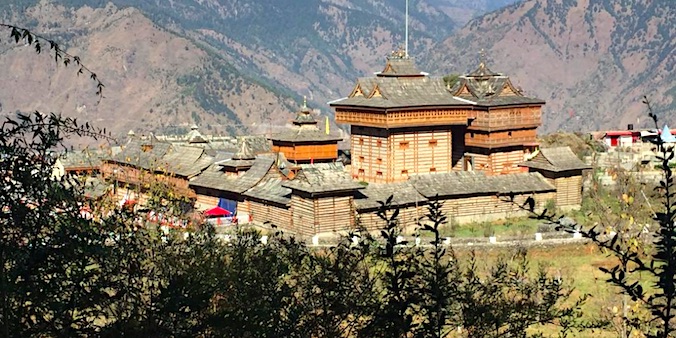
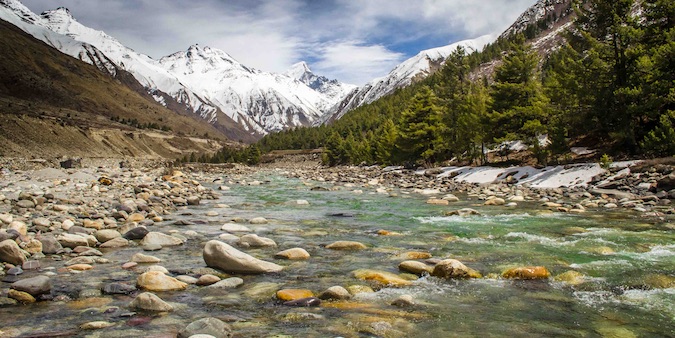
SANGLA VALLEY
Tabo Gompa
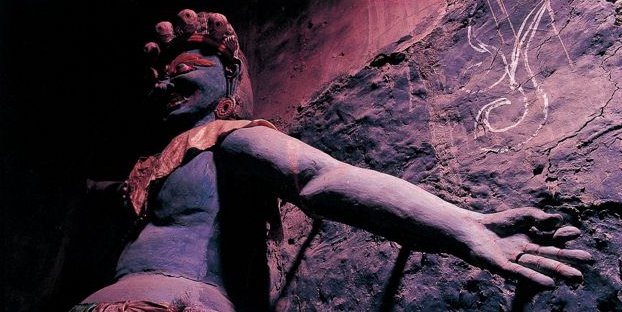
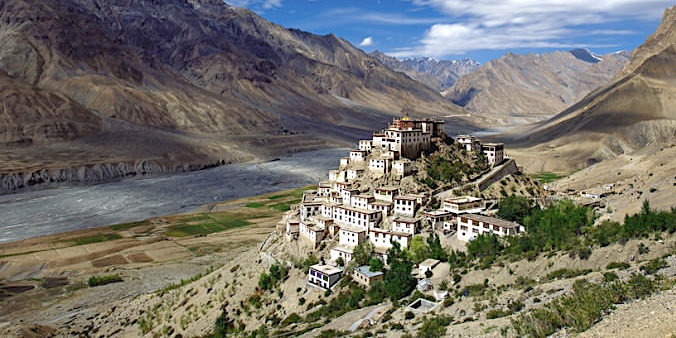
Spiti Valley
High Villages of Spiti


HIMALAYA CROSSING
HIGH PLATEAU of CHANGTANG
P.M.


LEH
CARAVAN ROADS OF LADAKH
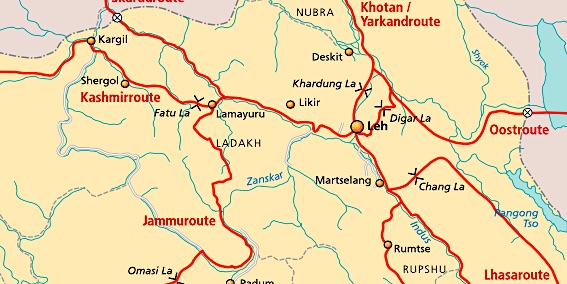

LOWER INDUS VALLEY (WEST)
SHAM AREA

